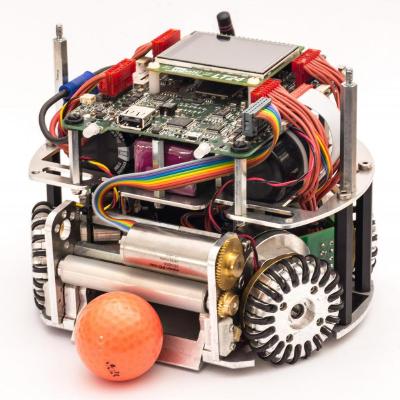Two technical challenges and the Mixed team tournament will be held this year.
These challenges are designed to encourage SSL teams to develop technical contributions and to test ideas that can evolve the league towards the RoboCup goal of 2050. In order to motivate more teams to participate in the challenges, there is no qualification constraint, and the Committes encourages all the participating teams to compete in the challenges.
Until April 25th, teams interested in participating in any of the challenges or in the Mixed team tournament need to announce their interest to the Organizing Committee . This is necessary for the preparation of the schedules.
Passing and Shooting Challenge
To test the ability of coordinated passing and motion of the teams, in an environment with moving obstacles, the following challenge is proposed: Up to four robots, placed within areas on each side the field, must pass and receive the ball across four moving obstacles, repositioning themselves according to the sequence shown in the figure below and, at the end, score the goal.
Rules
- Every received pass scores +1, and every intercepted or missed pass scores -1;
- There’s a bonus of +3 for scoring the goal;
- If the ball is intercepted, stops or goes out of bounds, it will be placed on the start position;
- The moving obstacles will travel at 1m/s speed, with slight variation allowed;
- The location of the obstacle robots will follow the figure, however their exact position may vary slightly;
- Robots cannot leave the areas of the field designated for them;
- Chip kicks are not permitted; – item added as Rule Clarification (June 7th)
- The size of each passing area is 1.25m x 6.1m, measured from the bounds of the field;
- Teams have 2 minutes to complete the challenge;
- Wins the team with higher score.
Pass/Intercept Challenge
Attention: This challenge’s format has changed on April 10th
This challenge tests both the ability to pass the ball in a reduced space, with adversaries, and the ability to intercept the ball when defending. The challenge occurs between two teams, on a half of the field. One of the teams, with up to four robots, tries to pass the ball as many times as possible, while the other team uses two robots to try to intercept the passes. Robots are free to move anywhere, as long as they respect the minimum distance between them, as shown on the picture below. The two teams swap passing and defending roles at the half-time interval.
Rules
- Every received pass scores +2 and every intercepted or missed pass scores -1;
- If the ball is intercepted, goes out of bounds or stops, a referee halt signal will be sent and the ball placed again around the goal kick position;
- Passing robots must keep minimum distance of 1m between teammates for passing score to be accounted;
- Defending robots must keep minimum distance of 0.5m from the robot holding the ball;
- Referee can penalize with -1 each offense to the minimum distance rules;
- Matches will consist of 2 periods of 2 minutes, with approx. 30 seconds interval between;
- Team with higher score wins;
- The challenge will follow eliminatory match style. Brackets will be drawn on the day of the competition.
Mixed Team Tournament
This is a full match between mixed teams, each composed of six robots originating from two different SSL teams. Each robot will be controlled by its originating SSL team software. However, communication between the teams is allowed, as long as there is no direct control of the robots. The tournament format will let teams play matches as members of different mixed teams.
* The exact number of matches and schedule will be announced by the OC after the team confirmation deadline.
Rules
- Both teams forming the mixed team must have the same number of robots on the field at the beginning of a match;
- All SSL rules will apply;
- Goals are only valid if robots from the two forming teams have touched the ball since the last game stoppage;
- The mixed teams will be formed by seeding.
- The winner is based off two round robins, a preliminary and a final one with advanced teams.
